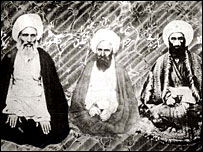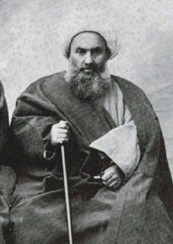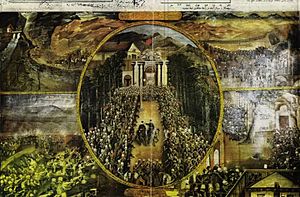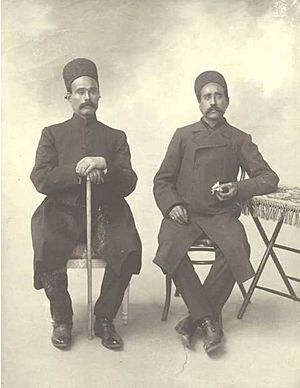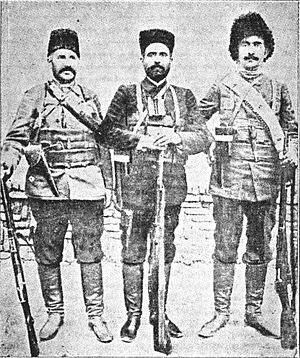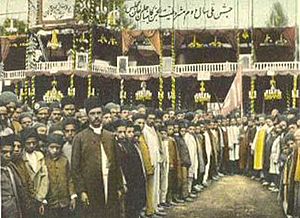Persian Constitutional Revolution facts for kids
Quick facts for kids Persian Constitutional Revolution |
|||||
|---|---|---|---|---|---|
| Part of constitutionalization attempts in Iran | |||||
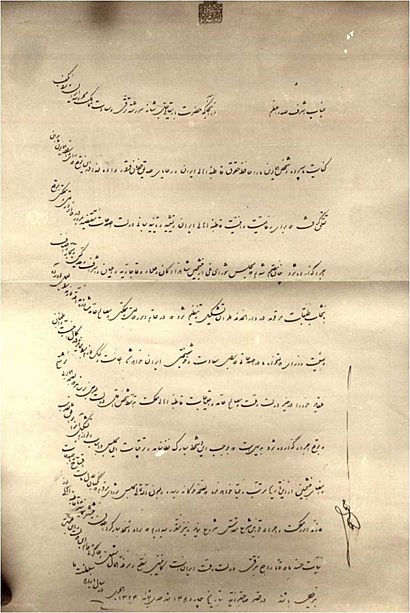
Royal proclamation by Mozaffar ad-Din Shah Qajar which established the constitutional monarchy on August 5, 1906
|
|||||
| Date | 1905–1911 | ||||
| Location | |||||
| Resulted in |
|
||||
| Parties to the civil conflict | |||||
|
|||||
| Lead figures | |||||
|
|||||
The Persian Constitutional Revolution (also called the Constitutional Revolution of Iran) was a big event in Iran (then called Persia). It happened between 1905 and 1911. During this time, people wanted to change how their country was ruled.
Before the revolution, the country was led by a king, or Shah, who had all the power. The revolution aimed to create a constitutional monarchy. This means the king would still be there, but his power would be limited by a constitution and a parliament. A parliament is a group of elected people who make laws for the country.
This revolution was very important for Persia. It was the first of its kind in the Islamic world. It opened the door for modern ideas and more freedom of speech. Many different groups worked together to make these changes happen.
King Mozaffar ad-Din Shah Qajar signed the new constitution in 1906, just before he passed away. But the next king, Mohammad Ali Shah, did not like the constitution. He tried to get rid of it and even attacked the parliament building in 1908.
This led to more fighting. People who supported the constitution marched to the capital city, Tehran. They forced Mohammad Ali Shah to step down. His young son, Ahmad Shah Qajar, became the new king, and the constitution was brought back in 1909. The revolution finally ended in December 1911.
Contents
What Caused the Revolution?
The Constitutional Revolution started in 1905. People were unhappy with how the country was being run. The king, Mozaffar ad-Din Shah Qajar, was borrowing a lot of money from other countries, like Russia. He used this money for expensive trips to Europe.
To pay back these loans, the government put high taxes on goods coming into the country. This hurt local businesses and merchants. Many people felt that Iran's wealth, like its oil, was being sold off to foreign countries, especially Britain.
The main groups who wanted change were:
- Merchants: Business owners from the bazaar (market) were losing money because of foreign goods and taxes.
- Religious leaders (Ulama): These scholars were powerful and often spoke for the people.
- Reformers: A small group of educated people who wanted modern changes.
They believed the king was selling off Iran's future. They wanted a system where laws protected everyone, not just the king.
Why People Were Unhappy
In the late 1800s, Iran faced many problems. Other powerful countries, like Russia and Britain, had a lot of influence. Iran had lost land and paid money to Russia in past wars. The country's army was not strong.
The kings of Iran, called the Qajar Shahs, often used local tribes to control rebellions. This could be very destructive. Roads were bad, and tax collectors often took too much from people.
Foreign countries also got special deals for trade. This meant their goods were cheaper, which hurt local Iranian businesses. For example, many Iranian weavers lost their jobs because of cheap imported textiles. Farmers also suffered as prices for their crops dropped.
In 1872, one king, Naser al-Din Shah Qajar, even tried to give a British person control over many parts of Iran's economy, like roads, telegraphs, and factories. People were very angry, and this deal was stopped.
A war between Russia and Japan in 1904-1905 also inspired Iranians. Japan, an Asian country with a constitution, defeated Russia, a European country without one. This made many Iranians think that having a constitution was the "secret of strength."
Who Wanted Change?
The movement for a constitution brought together different groups:
- Religious leaders (Ulama): They wanted more power for themselves and for Islamic laws to be followed strictly.
- Educated people: Many had traveled abroad and saw how well Western countries were doing. They wanted more fairness and less harsh rule in Iran.
- Merchants (Bazaaris): They wanted laws to protect their businesses and property from unfair actions by the government.
These groups had different reasons, but they all agreed that the king's power needed to be limited.
The Tobacco Protest
A big event before the revolution was the Tobacco Protest in 1891-1892. The king gave a British person control over all tobacco in Iran for 50 years. This angered many Iranians, especially farmers and merchants who worked with tobacco.
Religious leaders called for people to stop using tobacco. Even though Iranians loved tobacco, the ban was so successful that people stopped smoking it everywhere. This showed Iranians that they could stand up to the king and foreign influence. It was like a practice run for the bigger revolution to come.
Mozaffar ad-Din Shah
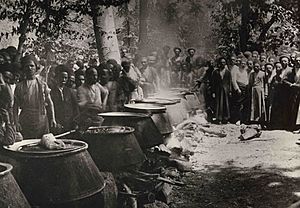
When Mozaffar ad-Din Shah Qajar became king in 1896, Iran was in a financial crisis. He continued his father's habit of spending too much. He took large loans from Russia and Britain. He even borrowed money to pay for a royal trip to Europe.
Because of this, many people, including nobles, religious leaders, and educated people, started to demand that the king's power be controlled by laws.
The Start of Protests
In 1905, protests began because of the high taxes used to pay back the Russian loan. Two merchants in Tehran were punished unfairly for raising prices. This made the city's merchants angry, and they closed their shops in protest. Religious leaders joined them.
The protesters went to a mosque for safety, but the government forced them out. This led to a bigger protest, with people seeking safety at a holy shrine outside Tehran. The king gave in on January 12, 1906. He agreed to fire his prime minister and create a "house of justice," which would later become the parliament. The protesters returned to Tehran like heroes.
Later, government forces killed a religious leader and other protesters. The bazaar closed again, and many religious leaders went on strike. Many merchants went to the British embassy in Tehran for safety, and the embassy agreed to protect them.
Creating the Constitution
During the summer of 1906, about 12,000 men camped at the British embassy. They talked about politics and demanded a parliament (majlis). They wanted to limit the king's power.
King Mozaffar ad-Din Shah agreed to a parliament in August 1906. The first elections were held that fall. Most of the elected members were from Tehran and were merchants.
The National Consultative Assembly met for the first time in October 1906. The king was old and sick. He signed the constitution on December 31, 1906, making his power dependent on the people's will. He passed away three days later.
What the Constitution Said
The constitution was officially announced on August 5, 1906. It was based on the Quran and partly on the Belgian constitution.
The election rules said who could vote. Women, foreigners, men under 25, and criminals could not vote. Members of parliament had to be literate, Iranian, and between 30 and 70 years old.
The laws also created a parliament with two parts. It said that Twelver Shi'ism was the state religion. A group of five high-ranking religious leaders would make sure that new laws followed Islamic rules.
Mohammad Ali Shah's Rule
Shah Muhammad Ali became king in January 1907. He did not like the constitution. The British government then stopped supporting the constitutionalists and sided with the king.
In August 1907, Britain and Russia signed an agreement. They divided Iran into a Russian zone in the north and a British zone in the south. The middle part was neutral. This showed how weak Iran's government was.
Civil War (1908-1909)
In 1908, the king tried to get rid of the parliament. He staged a coup and attacked the parliament building. This period is sometimes called the "Minor Tyranny." Some religious leaders, like Sheikh Fazlollah Nouri, who had supported the constitution earlier, now sided with the king.
Iran tried to stay free from Russian influence. The parliament appointed an American, William Morgan Shuster, to manage Iran's money. Russia demanded that Shuster be expelled and the parliament closed. Russian troops then occupied the city of Tabriz.
After the king's soldiers attacked the parliament in Tehran, 40,000 soldiers were sent to attack Tabriz. Constitutional rebels were fighting there. Sattar Khan became the leader of the constitutionalist forces. He and his lieutenant, Baqir Khan, became heroes for their bravery.
Inspired by this, constitutionalists across Iran formed groups. Powerful tribal leaders also joined the fight. Constitutionalist forces marched to Tehran. They forced Mohammad Ali Shah to give up his throne to his young son, Ahmad Shah Qajar. The constitution was brought back in 1909.
Later, there was a small conflict among the revolutionaries. A group of fighters led by Sattar Khan refused to give up their weapons. The new police chief, Yeprem Khan, disarmed them after a short fight.
The End of the Revolution
The revolution ended in December 1911. The parliament members faced many problems, including disagreements among themselves and opposition from powerful groups. With the support of 12,000 Russian troops, the king's government forced the parliament members out. They were even threatened if they tried to return.
Religious Views During the Revolution
Religious leaders had a lot of influence in Iran. The 1891 fatwa (religious ruling) against tobacco showed their power. It proved that they could unite people against the king and foreign interests.
During the revolution, religious leaders were on both sides.
- For the Constitution: Three very important religious leaders from Najaf, Iraq – Akhund Khurasani, Mirza Husayn Tehrani, and Shaykh Abdullah Mazandarani – supported the constitution. They believed that a democracy, even if not perfect, was better than a king with absolute power.
- Against the Constitution: Sheikh Fazlollah Nouri was a leader against the constitution. He believed that Islamic law (sharia) was enough for all aspects of life and that a new constitution was unnecessary and against Islam. He was a wealthy official and had a strong interest in keeping things as they were.
Nouri even contacted the Russian embassy for support and used criminal gangs to attack supporters of democracy.
Important Religious Rulings
The parliament members often asked Akhund Khurasani for his religious opinion on new laws. When anti-constitutionalists tried to undermine democracy, Akhund Khurasani and the other two leaders replied:
| Persian | English |
|---|---|
|
اساس این مجلس محترم مقدس بر امور مذکور مبتنی است. بر هر مسلمی سعی و اهتمام در استحکام و تشیید این اساس قویم لازم، و اقدام در موجبات اختلال آن محاده و معانده با صاحب شریعت مطهره علی الصادع بها و آله الطاهرین افضل الصلاه و السلام، و خیانت به دولت قوی شوکت است. الاحقر نجل المرحوم الحاج میرزا خلیل قدس سره محمد حسین، حررّہ الاحقر الجانی محمد کاظم الخراسani، من الاحقر عبدالله المازندرانی |
"It is important for every Muslim to support this parliament. Those who try to stop it are going against Islamic law and betraying the government." --Mirza Husayn Tehrani, Muhammad Kazim Khurasani, Abdallah Mazandaran. |
When Sheikh Fazlollah Nouri sided with the king and caused trouble, Akhund Khurasani and his fellow leaders issued another statement:
| Persian | English |
|---|---|
|
چون نوری مخل آسائش و مفسد است، تصرفش در امور حرام است. محمد حسین (نجل) میرزا خلیل، محمد کاظم خراسانی، عبدالله مازندرانی |
"Because Nouri is causing trouble, his actions are forbidden." --Mirza Husayn Tehrani, Muhammad Kazim Khurasani, Abdallah Mazandaran. |
They later called for Nouri to be expelled from Tehran.
Nouri's Punishment
Nouri joined King Mohammad Ali Shah when the king tried to overthrow the parliament in 1907. But in 1909, the constitutionalists marched into Tehran and arrested Nouri.
A special court found Nouri guilty of causing trouble and declaring parliament leaders to be enemies of Islam. In July 1909, Nouri was executed for his actions.
Legacy of the Revolution
The Persian Constitutional Revolution had a mixed legacy in Iran.
Years later, Ruhollah Khomeini, who led the 1979 Islamic Revolution, said that the 1906 constitution was a trick by foreign powers to harm Islam. He believed that the laws were copied from European countries and only pretended to include Islamic rules.
After the 1979 Islamic Revolution, Sheikh Fazlollah Nouri, who had opposed the constitution, was honored in Iran. A highway was even named after him. This was interesting because Nouri had supported the monarchy against the constitution, while the Islamic Revolution was about overthrowing the king.
Historian Reza Aslan says that the revolution teaches us an important lesson. Big changes in Iran happened when three groups worked together:
- Educated middle class
- Mid-level religious leaders and students
- Business owners (bazaari merchants)
These groups, when united, had the power to bring about major change.
Notable People in the Revolution
Constitutionalists
- Mirza Nasrullah Khan – First elected Prime Minister of Iran.
- Mirza Jahangir Khan – Editor of the Sur-e Esrafil newspaper.
- Mirza Sayyed Mohammad Tabatabai
- Sattar Khan – A key revolutionary leader.
- Baqir Khan – A national hero.
- Yeprem Khan – An Armenian Iranian revolutionary leader and later police chief.
- Sardar Assad – A tribal leader whose forces helped capture Tehran.
- Bibi Khanoom Astarabadi – A writer and pioneer for women's rights.
- Mohammad Vali Khan Tonekaboni – Leader of revolutionary forces from northern Iran.
- Howard Baskerville – An American teacher who fought with the constitutionalists.
- Mohammed Mosaddeq – A future prime minister of Iran.
Monarchists (Against the Constitution)
- Abdol Majid Mirza
- Sheikh Fazlollah Nouri – A religious leader who was executed after the revolution.
- Vladimir Liakhov – A Russian colonel who commanded the Persian Cossack Brigade and attacked the parliament.
Religious Leaders (by their stance)
- Constitutionalists:
- Mohammad-Kazem Khorasani
- Sayyed Jamal ad-Din Esfahani
- Sayyed Abdullah Behbahani
- Mirza Sayyed Mohammad Tabatabai
- Mirza Hussein Naini
- Anti-Constitutionalists:
- Mohammed Kazem Yazdi
- Sheikh Fazlollah Nouri
See also
 In Spanish: Revolución constitucional iraní para niños
In Spanish: Revolución constitucional iraní para niños
- History of Iran
- Iranian Revolution of 1979
- Tobacco Protest
- Triumph of Tehran



